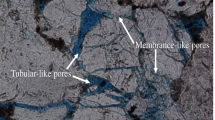Abstract
Based on the percolation network model characterizing reservoir rock’s pore structure and fluid characteristics, this paper qualitatively studies the effects of pore size, pore shape, pore connectivity, and the amount of micropores on the I-S w curve using numerical modeling. The effects of formation water salinity on the electrical resistivity of the rock are discussed. Then the relative magnitudes of the different influencing factors are discussed. The effects of the different factors on the I-S w curve are analyzed by fitting simulation results. The results show that the connectivity of the void spaces and the amount of micropores have a large effect on the I-S w curve, while the other factors have little effect. The formation water salinity has a large effect on the absolute resistivity values. The non-Archie phenomenon is prevalent, which is remarkable in rocks with low permeability.
Similar content being viewed by others
References
Dullien, F. A. L. 2001, Porous media fluid transport and pore structure (Second Edition), Academic Press, China.
Lenormand, R., Zarcone, E. and Zarcone C, 1988, Numerical models and experiments on immiscible displacements in porous media: J. Fluid Mech, 189, 165–187.
Li Ning, 1989, General forms of the resistivity porosity and resistivity-oil (gas) saturation relations, as well as the determination of their optimum approximation function types (I): Acta Geophysica Sinica, 32, 580–591.
Mao Zhiqiang, and Gao Chuqiao, 2000, Theoretical simulation of resistivity and pore structure of hydrocarbon bearing rocks: Petroleum Exploration and Development, 27, 87–90.
Suman, R. J., and Knight, R. J., 1997, Effect of pore structure and wettability on the electrical resistivity of partially saturated rock—a network study: Geophysics, 62, 1151–1162.
Worthington, P. F., and Pallatt, N., 1990, Effect of variable saturation exponent upon the evaluation of hydrocarbon saturation: SPE 20538, 101–106.
Yue Wenzheng, Tao Guo, and Zhu Keqin, 2004, Simulation of electrical properties of rock saturated with multi-phase fluids using lattice gas automation: Chinese Journal of Geophysics, 47, 905–910.
Author information
Authors and Affiliations
Additional information
This project is sponsored by National Natural Science Foundation of China, No. 40574030.
First Author
Wang Kewen, PhD student at China University of Petroleum (east china), received bachelor degree in application physics from University of Petroleum (East China) in 2002. His research interests are microcosmic simulation of reservoir characteristics and its applications.
Rights and permissions
About this article
Cite this article
Wang, K., Sun, J., Guan, J. et al. Percolation network modeling of electrical properties of reservoir rock. Appl. Geophys. 2, 223–229 (2005). https://doi.org/10.1007/s11770-005-0028-2
Received:
Revised:
Issue Date:
DOI: https://doi.org/10.1007/s11770-005-0028-2




